September 2024
The global external pacemaker market size is accounted at USD 1.89 billion in 2025 and is forecasted to hit around USD 2.56 billion by 2034, representing a CAGR of 3.41% from 2025 to 2034. The North America market size was estimated at USD 770 million in 2024 and is expanding at a CAGR of 3.44% during the forecast period. The market sizing and forecasts are revenue-based (USD Million/Billion), with 2024 as the base year.
The global external pacemaker market size accounted for USD 1.83 billion in 2024 and is predicted to increase from USD 1.89 billion in 2025 to approximately USD 2.56 billion by 2034, expanding at a CAGR of 3.41% from 2025 to 2034. The external pacemaker market is projected to continue its upward trajectory, fuelled by ongoing technological advancements and expanding patient populations owing to the rising cardiovascular diseases world widely.
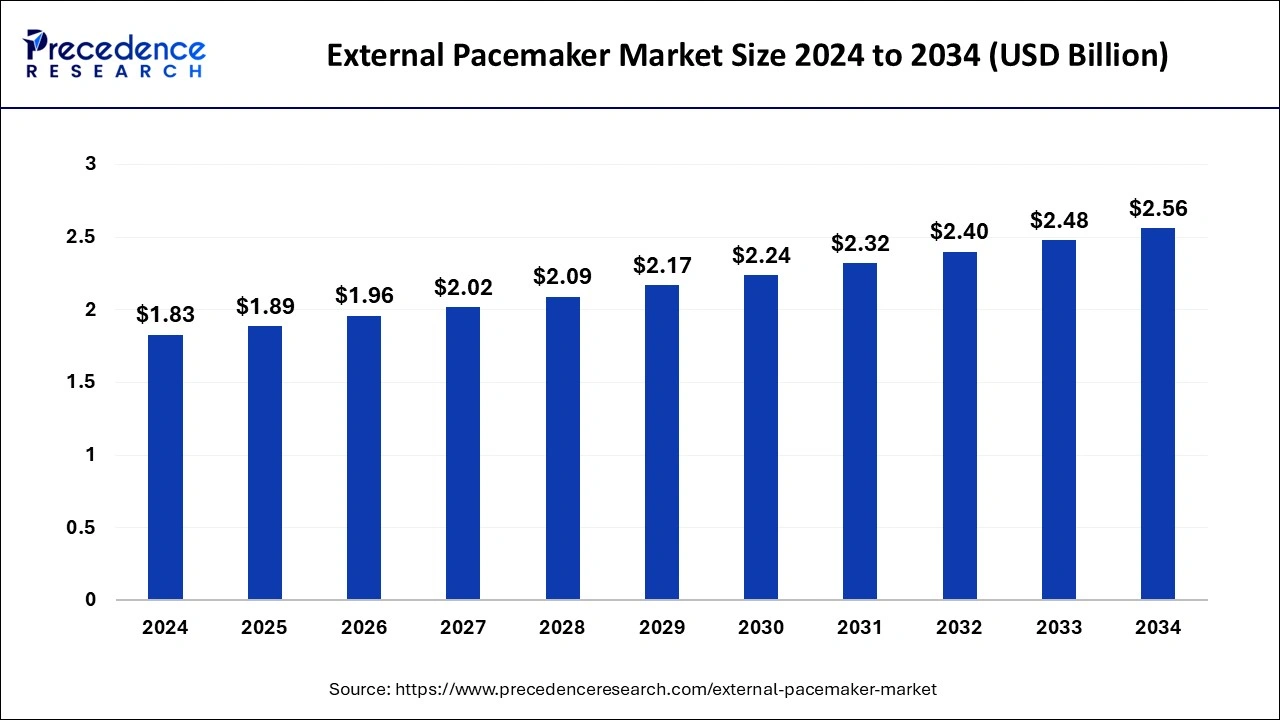
The U.S. external pacemaker market size was exhibited at USD 580 million in 2024 and is projected to be worth around USD 820 million by 2034, growing at a CAGR of 3.52% from 2025 to 2034.
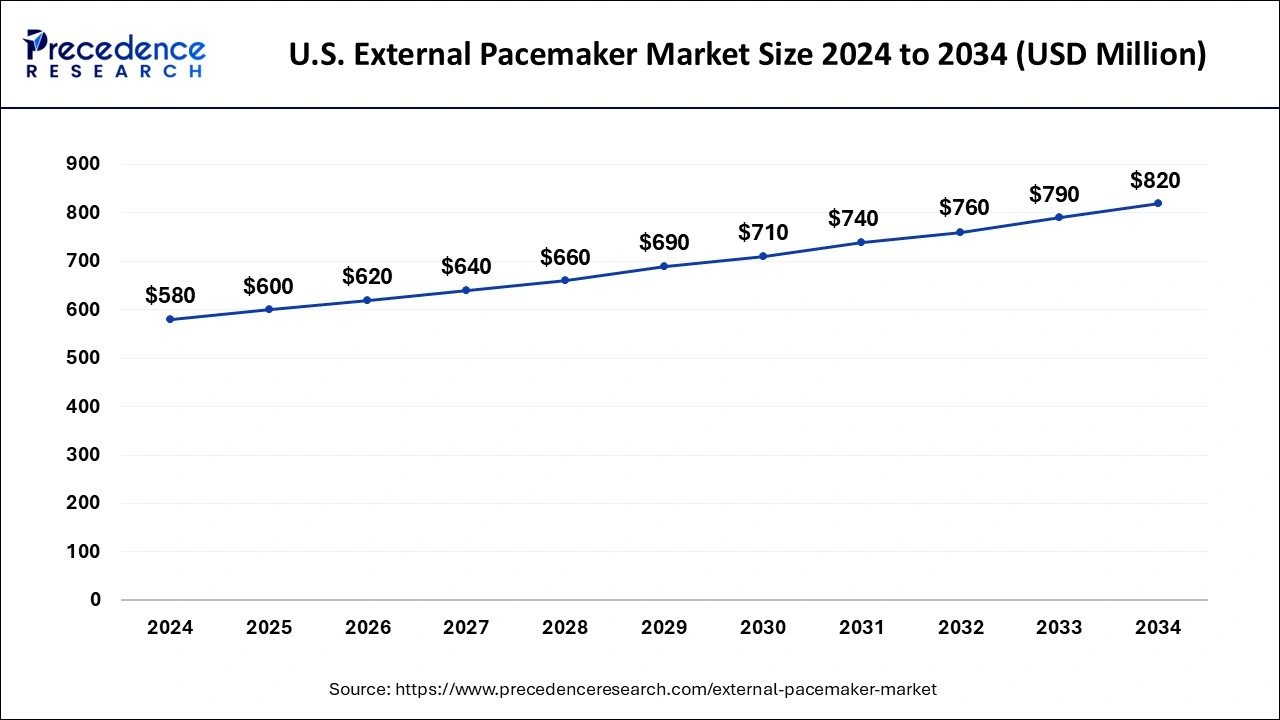
North America dominated the global external pacemaker market and expected to continue its hold even in the forecast period. In North America, particularly in the United States, the external pacemaker market is well-established and dominated by advanced medical technology companies.
The U.S. has a large population affected by cardiovascular diseases, including arrhythmias and heart blockages, which necessitates a high demand for external pacemakers. With a robust healthcare infrastructure, extensive research and development capabilities, and a favourable regulatory environment, the U.S. remains at the forefront of innovation in cardiac care solutions.
Canada, although smaller in population compared to the U.S., also contributes significantly to the North American market with its well-developed healthcare system and growing adoption of advanced medical technologies. Both countries continually witness technological advancements and increasing adoption of external pacemakers due to factors such as aging demographics and lifestyle-related health issues.
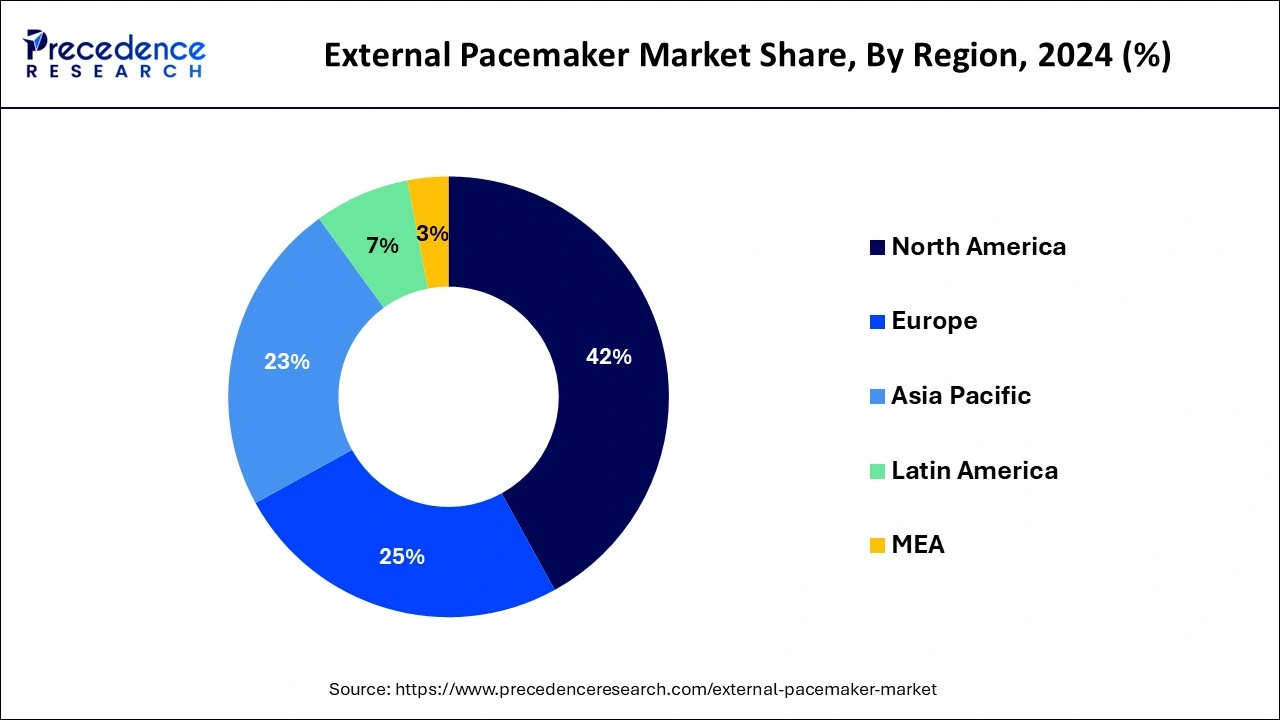
The Asia Pacific region is experiencing rapid growth in the external pacemaker market, driven by countries such as China, Japan, and India. These nations are witnessing significant urbanization, lifestyle changes, and aging populations, leading to a higher prevalence of cardiovascular diseases. As a result, there is a growing demand for advanced cardiac care solutions, including external pacemakers, to address the healthcare needs of the population.
Moreover, improving healthcare infrastructure, increasing disposable incomes, and expanding access to medical services are further driving market growth in the region. Recent instances include strategic partnerships between multinational medical device companies and local distributors to expand market reach and government initiatives aimed at improving healthcare access and affordability, particularly in rural areas. These factors collectively contribute to the Asia Pacific region's emergence as a key growth market for external pacemakers.
The external pacemaket market is witnessing steady growth driven by advancements in cardiac care technology and an increasing prevalence of cardiovascular diseases globally. With a focus on portability and ease of use, manufacturers are developing innovative external pacemakers to cater to diverse patient needs. Key players in the market are investing in research and development to enhance product efficacy and reliability while adhering to stringent regulatory standards. Rising healthcare expenditure and growing awareness about cardiac health are also contributing to market expansion.
However, challenges such as high costs associated with advanced devices and potential complications during device implantation hinder market growth. Despite these challenges, the external pacemaker market is projected to continue its upward trajectory, fuelled by ongoing technological advancements and expanding patient populations.
| Report Coverage | Details |
| Market Size in 2025 | USD 1.89 Billion |
| Market Size in 2024 | USD 1.83 Billion |
| Market Size by 2034 | USD 2.56 Billion |
| Growth Rate from 2025 to 2034 | CAGR of 3.41% |
| Largest Market | North America |
| Base Year | 2024 |
| Forecast Period | 2025 to 2034 |
| Segments Covered | Product, Application, and End-user |
| Regions Covered | North America, Europe, Asia-Pacific, Latin America, and Middle East & Africa |
Cardiovascular diseases worldwide
The primary driver for the market is the increasing prevalence of cardiovascular diseases worldwide. As more people are affected by conditions like arrhythmias and heart blockages, there's a growing need for effective cardiac rhythm management solutions. External pacemakers provide a non-invasive and temporary way to regulate heartbeats, offering patients a lifeline while they await more permanent treatment options like implantable devices or surgery. Cardiovascular disease (CVD) serves as a significant driver for the external pacemaker market due to its prevalence and impact on heart rhythm management.
External pacemakers play a crucial role in managing cardiac rhythm disorders associated with CVD by providing electrical stimulation to regulate the heart's beating pattern. As the prevalence of CVD continues to rise globally, driven by factors such as aging populations, sedentary lifestyles, and unhealthy dietary habits, the demand for external pacemakers is expected to increase.
the increasing burden of CVD shows the importance of external pacemakers as a vital therapeutic intervention for managing heart rhythm disorders and improving patient outcomes. As healthcare systems strive to address the growing prevalence of CVD and its associated complications, the demand for external pacemakers is likely to remain strong, driving market growth in the coming years.
High cost
One significant restraint for the external pacemaker market is the high cost associated with advanced devices. While these devices offer valuable cardiac care solutions, their price can be prohibitive for some patients and healthcare systems. Additionally, potential complications during device implantation procedures can pose challenges and increase healthcare costs. These factors may limit market growth and accessibility for certain patient populations. Hence, the high cost associated with external pacemakers can be a barrier to access for some patients, particularly those without adequate health insurance coverage or financial resources.
Ongoing research and development
An opportunity for the external pacemaker market lies in expanding applications and adoption of these devices. With ongoing research and development, external pacemakers could become more versatile in addressing a wider range of cardiac conditions and patient needs. Moreover, opportunities exist in emerging markets where there's a growing demand for affordable and accessible cardiac care solutions. By innovating and diversifying product offerings, manufacturers can tap into new market segments and increase their market share.
Technical advancements in external pacemakers have significantly improved their functionality, reliability, and patient comfort.
The dual chamber segment held the largest market share of external pacemaker market accounted in 2024 and thus dominated the market globally. Rising prevalence of cardiac diseases such as, atrial fibrillation and cardiac arrhythmias are driving the market owing to the higher demand for such fatal conditions found in people frequently on a wider scale.
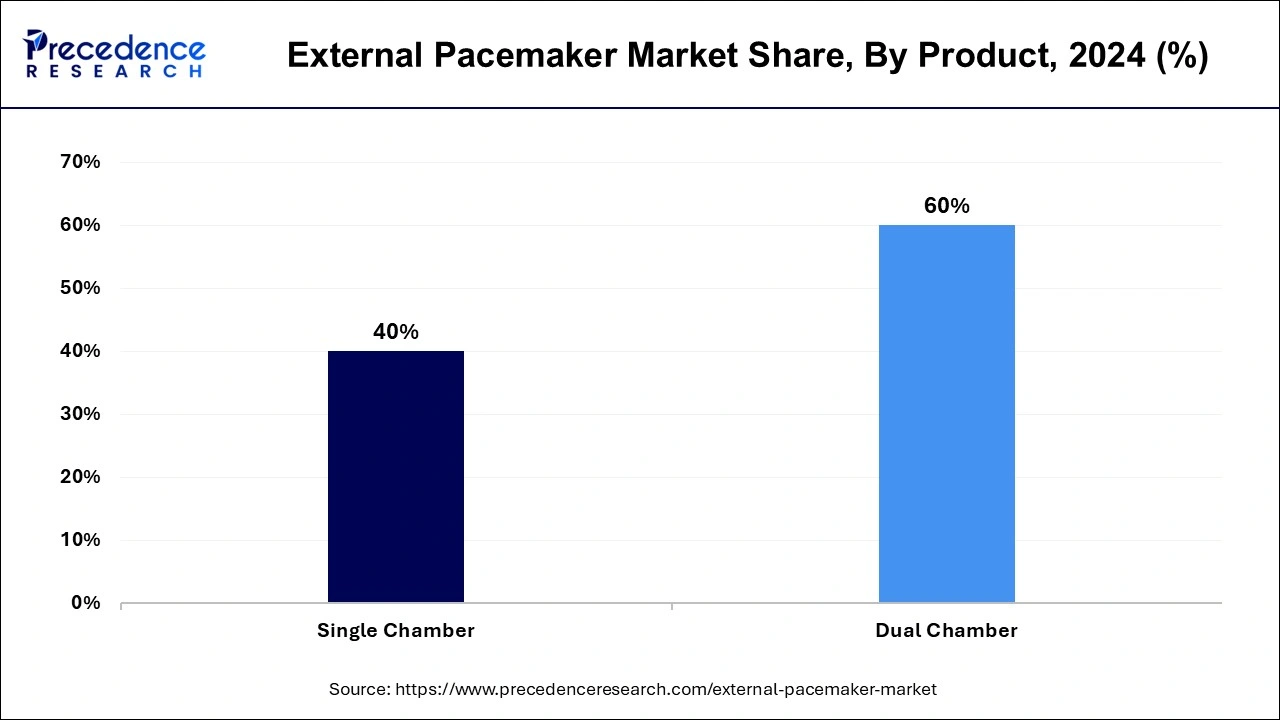
Dual chamber pacemaker comprises with two leads which placed properly by medical skilled professionals so they can act synchrony if they detect lower hear rate to mimic the natural sequential contractions of the ventricular and atria. These aids in increasing heart rate that is able to keep heart health on optimum level.
The single chamber segment expected to be fastest growing segment in the external pacemaker market. The growth of this segment is attributed to the factors such as it involves lesser risk after surgical intervention, and it is non-invasive device. Along with this, these devices can track heart activities on a daily basis. These are easily available devices to synchronize the cardiac Rythm of individual suffering from heart disease.
The bradycardia segment accounted for largest market share of in 2024, it's expected to hold its position in the foreseen period. Growth of this segment is related with the rising obesity and fat saturation due to the sedentary lifestyle of induvial along with increase in alcohol consumption by higher rate since, very young age contributing the fatal conditions like cardiac arrest has been risen globally.
According to the data collected in the covid-19 crisis, patients having heart rate fluctuations and bradycardia are the major reason for worsening the covid symptoms and turns into prolonged stay in the Intensive care units. Hence, growing prevalence of cardiac diseases fuelling the adoption of technically advanced appliances for medical applications, eventually propelling the external pacemaker market on a global level.
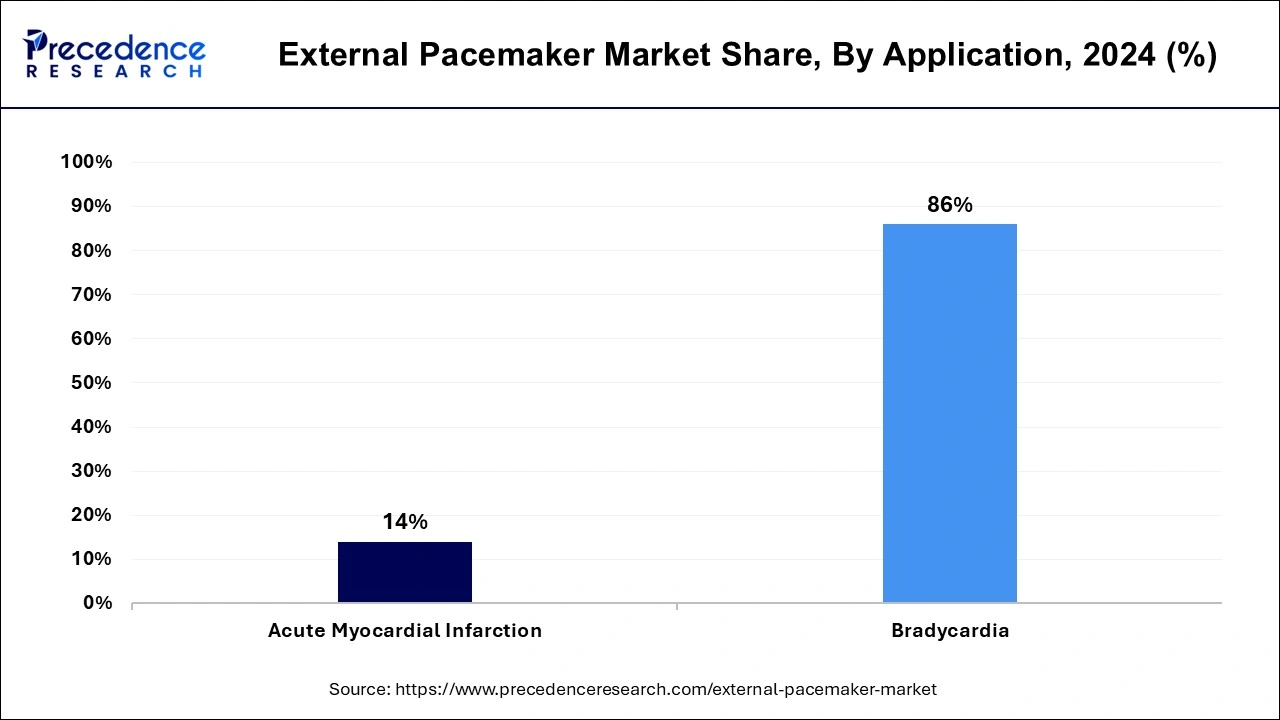
The acute myocardial infarction segment is anticipated to witness a promising growth rate in the foreseeable period. The growth of this segment majorly depends upon the rising cases of myocardial infarction due to the unhealthy eating habits, not maintaining circadian Rythm or poor sleep patterns fuelling the stress level and psychological disorder which ultimately affect the whole physiological process and manifest itself into the fatal diseases like cardiac arrest even at a young age population.
The hospitals segment accounted to hold the largest market revenue in 2024 owing to the advanced facilities provided by hospitals and thus dominated the market on a global level. The hospital segment is a significant contributor to the external pacemaker market, playing a crucial role in the diagnosis, treatment, and management of cardiovascular diseases requiring cardiac rhythm management. Hospitals serve as primary centers for the implantation and monitoring of external pacemakers, providing patients access to specialized cardiac care services and medical expertise.
Within hospitals, various departments such as cardiology, electrophysiology, and cardiovascular surgery are involved in the process of evaluating patients for external pacemaker therapy, performing device implantation procedures, and overseeing post-implantation care and monitoring.
As the demand for cardiac care continues to rise globally, fuelled by factors such as aging populations and lifestyle-related health issues, the hospital segment is expected to remain a key market for external pacemakers, facilitating access to life-saving cardiac rhythm management therapies for patients in need.

The ambulatory surgical centers segment is showing a promising future growth and become notably growing segment in the global external pacemaker market. Ambulatory surgical center (ASCs) are becoming a popular for external pacemaker procedures. These centres offer same-day surgeries for patients needing procedures like pacemaker implantation. They're gaining popularity because they provide high-quality care in a more convenient and cost-effective setting compared to traditional hospitals.
ASCs are equipped with advanced medical technology and staffed with skilled healthcare professionals who specialize in cardiac procedures. As,more people seek timely and efficient healthcare options, ASCs are expected to see significant growth in performing external pacemaker procedures. This trend reflects a broader shift towards outpatient care and reflects the growing importance of accessibility and convenience in healthcare services.
By Product
By Application
By End-user
By Geography
For inquiries regarding discounts, bulk purchases, or customization requests, please contact us at sales@precedenceresearch.com
No cookie-cutter, only authentic analysis – take the 1st step to become a Precedence Research client
September 2024
August 2024
August 2024
August 2024